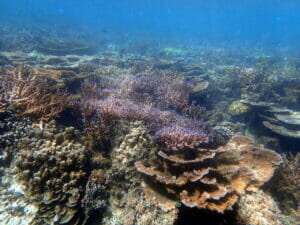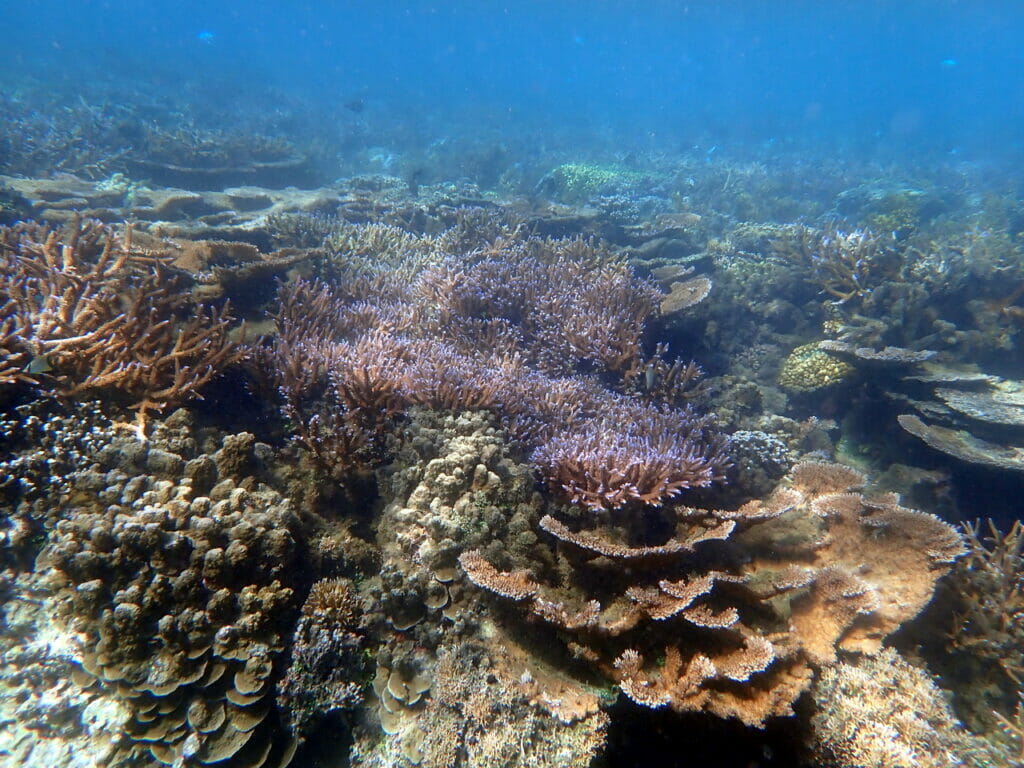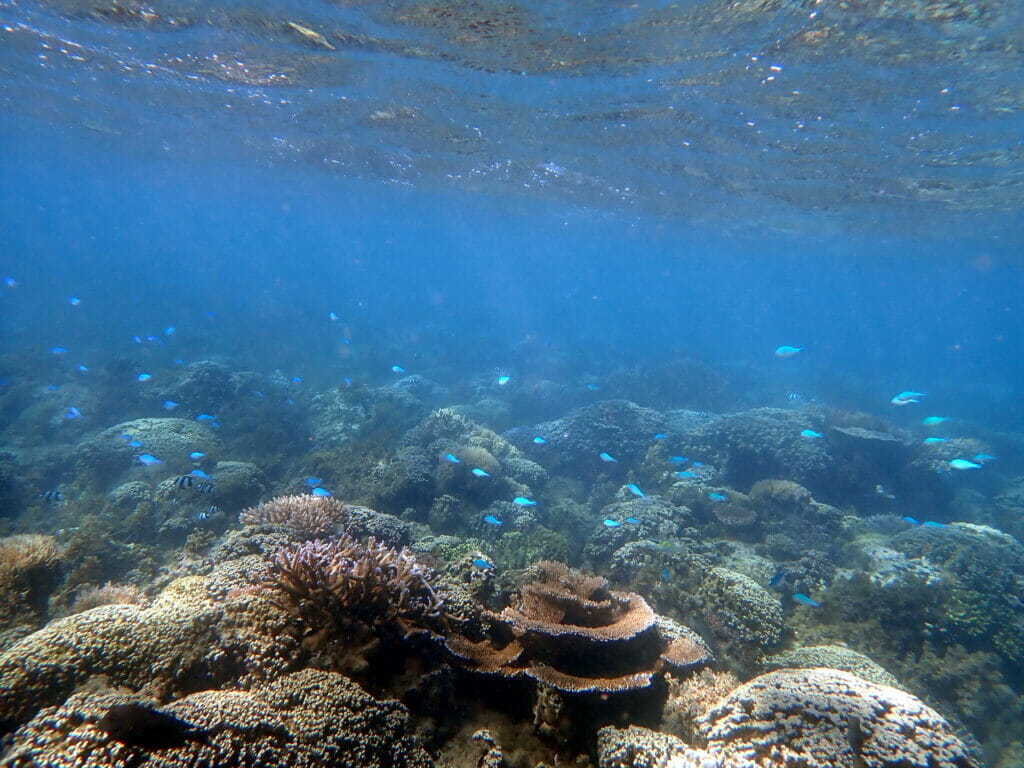GCRA WHITE PAPER
Integrated Biorock Blue Economy Strategy For Sustainable Islands And Coasts

Healthy coral reef, Upolu, Samoa. Ecosystem services of healthy biodiverse coral reefs like this have nearly vanished. Photographed June 2023, by Gideon Brosius.
INTRODUCTION: SUSTAINABLE BLUE ECONOMIES
Ocean-based “Blue economy” schemes are now popular with investors, governments, and international agencies, who claim wealth will flow from ocean resources.
Successful “blue economies” are nearly impossible to find because one marine resource after another has been destroyed or severely degraded by over-exploitation after becoming capitalized.
Coastal ecosystems around all populated coastlines are in advanced collapse, and have lost most biodiversity and ecosystem services.
Marine Protected Areas may slow down, but rarely prevents, marine resource collapse, and has not led to large scale regeneration of essential coastal ecosystem services like carbon sequestration, fisheries, shore protection, beach sand generation, tourism, biodiversity, etc.
Without regenerating dying coastal ecosystems and resources there will be NO Blue Economy, so an entirely different strategy is needed to increase marine productivity instead of destroying it!
Natural recovery is so slow that active ecosystem regeneration is needed, such methods are now available using Biorock Technology.
Here we present an Integrated and Sustainable Biorock Blue Economy Strategy (ISBBES) to regenerate all coastal ecosystem services in order to adapt to, and reverse, global warming and sea level rise that are not just out of control, they are headed for catastrophic overshoot. The ISBBES is an essential survival strategy for the first and most vulnerable victims of global climate change: coral reefs, low islands, and coasts.
METHODS: BIOROCK TECHNOLOGY
Biorock technology is a revolutionary method developed in, by, and for Small Island Developing States, first in Jamaica and then in more than 40 island nations across the Caribbean, Pacific, Indian Ocean, and Southeast Asia. Biorock grows solid rock structures of any size or shape in the sea, creating reefs full of life that grow back severely eroded beaches and regenerating marine ecosystems and fisheries. It increases biodiversity by greatly increasing settlement, growth, survival, and resistance to extreme environmental stress in all marine animals and plants studied.
Biorock technology also produces building materials harder than concrete that are carbon neutral or carbon negative, and far cheaper than Portland Cement, a major source of atmospheric CO2, while also producing green hydrogen fuels when low-cost solar power is used. Biorock regenerates all coastal ecosystems and their ecosystem services, in particular coastal protection from erosion, carbon storage, biodiversity, and fisheries. Biorock is the only method that protects coral reefs from bleaching. No other restoration method provides any of these benefits.
Biorock reefs grow faster than global sea level rise, so they provide permanent shore protection that will evolve to meet the needs of low islands and coasts for protection against global sea level rise that will increase greatly in coming decades and centuries, even if atmospheric CO2 and global warming are brought under control.
Artificial islands can be readily grown on shallow sea floors with Biorock, and floating Biorock reefs can serve as wave barriers to protect coasts, and create fisheries habitat even over the deep sea.
Suitable habitat for coral reefs to grow covers less than 0.1% of the ocean, but floating reefs are feasible over much of the ocean, for example around floating ocean thermal energy conversion (OTEC) power plants that make electricity from the temperature difference of the warm tropical ocean and the deep sea. Such Thermodynamic Geoengineering (TG) plants could make more fossil fuel free energy than the world uses, and slow down global warming by speeding vertical mixing of warm surface water with cold deep water. This could give coral reefs, low islands, and coasts the only known interim chance to survive climate overshoot until atmospheric CO2 can be reduced to safe pre-industrial levels. Small Island Developing States (Large Ocean Developing States), and low coastal countries will be major beneficiaries.
CONCLUSIONS: EXPECTED RESULTS
Biorock technology was invented and developed in Jamaica and islands around the world to protect small island developing states (SIDS). Biorock technology provides global integrated sustainable coastal zone management solutions to:
- Grow Biorock reefs that match sea level rise and protect coasts from erosion.
- Grow new sources of white limestone beach sand behind Biorock reefs.
- Protect coral reefs from global warming.
- Protect seagrass, salt marsh, and mangroves from erosion.
- Regenerate coral reef ecosystem biomass and biodiversity.
- Regenerate seagrass ecosystem biomass and biodiversity.
- Regenerate salt marsh ecosystem biomass and biodiversity.
- Regenerate mangrove ecosystem biomass and biodiversity.
- Regenerate oyster reef ecosystem biomass and biodiversity.
- Regenerate mussel reef ecosystem biomass and biodiversity.
- Integrated whole-ecosystem mariculture without feeding.
- Artificial islands on shallow sea floors.
- Floating reefs to absorb waves.
- Floating reefs to expand coral reefs to the deep ocean.
- Floating reefs for fisheries enhancement.
- Floating open ocean thermal energy conversion power plants.
- Harder, cheaper limestone building materials.
- Harder, cheaper cements that absorb CO2 directly from air.
- Beautiful, biodiverse coral reefs for Ecotourism.
- Carbon sequestration by coastal sediments.
- Reversing global climate change.
- Co-production of green solar hydrogen fuels, oxygen, and chlorine.
- Provides integrated sustainable development strategy for SIDS and low coasts.
REFERENCES FOR MORE INFORMATION
Biorock:
Biorock® Technology for Climate Proofing Beaches, Regenerating Marine Ecosystems, Sustainable Mariculture, Blue Carbon sequestration, climate change adaptation, and producing cheaper and harder carbon-neutral or carbon-negative building materials in the sea. Side Event at the United Nations Ocean Conference, Lisbon, Portugal, June 30 2022 by Dr. Tom Goreau, Chief Scientist, Blue Regeneration:
https://www.youtube.com/watch?v=6wDwCsxx4Q8
https://www.globalcoral.org/saving-coral-reefs-from-extinction-june-4-2023-2pm-est/
Thermodynamic Geoengineering:
http://gwmitigation.com/Thermodynamics.htm
https://www.sciencedirect.com/science/article/abs/pii/S136403211830532X
http://gwmitigation.com/Outreach.htm
A Sustainable Blue Economy with Thermodynamic Geoengineering to power Biorock technologies
Jim Baird jim.baird@gwmitigation.com
The Small Island Developing States, or SIDS, rebranded themselves as the Large Ocean Developing States (LODS) on the basis of the 30 percent of the global economic exclusion zones, or EEZs, they control.
- For example, Tuvalu, with a territorial land mass of 25.1 square kilometers, has an Exclusive Economic Zone of 753,139 square kilometers. An economic multiplier of 30,000 when this surface area is utilized to produce energy with ocean thermal energy conversion.
- And the 39 SIDS and 18 Associate Members of United Nations regional commissions that face unique social, economic and environmental vulnerabilities have similar potential with the same technology.
- But not all ocean thermal energy conversion is created equally.
- Typically, with conventional OTEC, water is brought to the surface by massive pipes to condense a working fluid after it has passed through a turbine to produce power after the working fluid was first vaporized using surface heat.
- The thermodynamic efficiency of this process is only about 3 percent and the 97 percent of the surface heat diluted by the cold water is dispersed outward towards the poles that in the case of the Artic is warmed 4 degrees over the course of 1,000 years at the same time as the tropics are cooled by the same amount.
- Instead of using an upwelling strategy, Thermodynamic Geoengineering, doesn’t allow water to move between the thermal layers of the ocean. It instead uses the phase changes of a working fluid to move heat from the surface to a depth of 1000 meters, which provides 226 years of global warming respite.
- It also mitigates the two greatest threat to island nations, sea level rise and storm surge.
- This is because the coefficient of expansion of sea water is half at 1000 meters it is at the surface, and heat moved into deep water isn’t available to melt polar and Himalayan icecaps and surface heat moved into deep water can’t power cyclones.
- Using phase changes of a working fluid, instead of with the sensible heat of water, heat is moved two and a half times more efficiently with Thermodynamic Geoengineering than with conventional OTEC, and accordingly Thermodynamic Geoengineering can produce two and half times more energy as well.
- At scale Thermodynamic Geoengineering can produce over twice as much energy as is currently being derived from fossil fuels.
- From a depth of 1000 meters heat diffuses back to the surface at a rate of 1 centimeter a day to the bottom of the mixed layer, and 1 meter per day through that layer. So, it is back at the surface in about 226 years where it can be recycled to produce more work.
- Over the course of 13 cycles, all the heat of warming can be converted to work and the waste heat of those conversions can be dissipated back to space thus eliminating the problem of global warming.
- An amalgam of the SIDS economic exclusion zones with the economic and technical might of the Asia-Pacific region are a recipe for a vibrant and prosperous sustainable blue economy that can thrive on the cheapest energy that can be had with Thermodynamic Geoengineering.
- For more information, please see https://www.youtube.com/watch?v=N8Ep5zuk4cA

